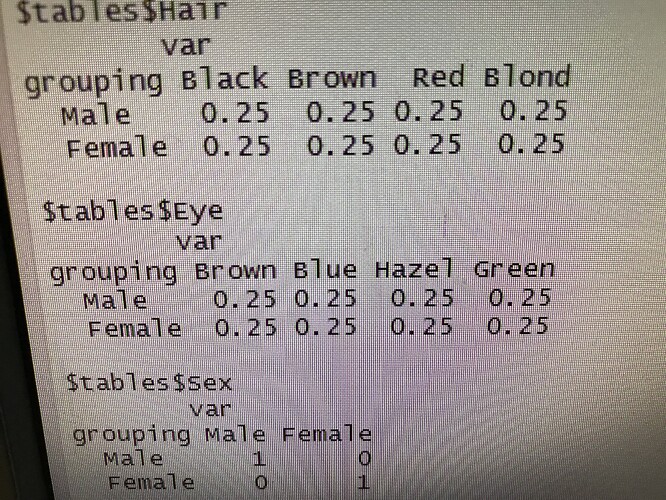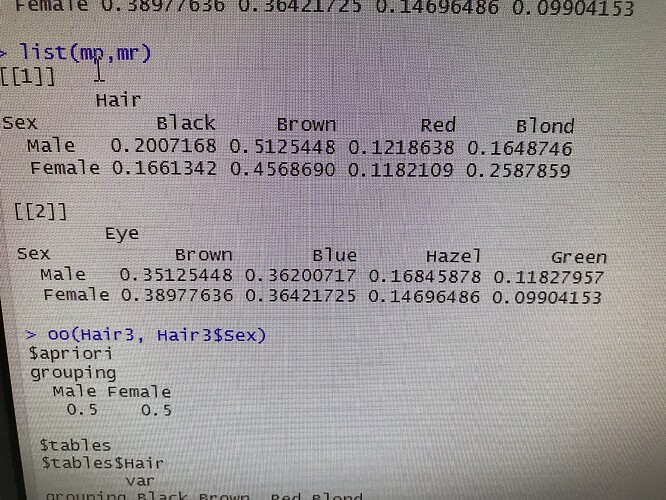Hey,
I've been given a rather tough request and I have consulted with many people on how to create such function but have struggled to do so.
I'm trying to write a function NB that, for which given a data frame with discrete values and a class,
returns the priors and likelihood function.
I've been told that my answers can be verified for the HairEyeColor dataset by using the Naive Bayes Classifier in R (package e1071)
I understand that this is a rather difficult question, so i am sorry for any inconvenience of your time this may cause!
Thankyou!!
Jennifer
What have you tried so far? Can you post a small reprex with sample data, your code, and what your desired output looks like?
That’s the problem because I’m not sure if where to start at all. Also the HairEycolour dataset is in r studio…I’ve tried to create the function myself but It hasn’t had much luck and is very off topic I’ve been told
I've been working on what the output should look like for the past 5 days and have been able to figure out what this function should give me. The sample data is as follows:
> HairEyeColor
, , Sex = Male
Eye
Hair Brown Blue Hazel Green
Black 32 11 10 3
Brown 53 50 25 15
Red 10 10 7 7
Blond 3 30 5 8
, , Sex = Female
Eye
Hair Brown Blue Hazel Green
Black 36 9 5 2
Brown 66 34 29 14
Red 16 7 7 7
Blond 4 64 5 8
When applying the function NB, with the given dataset above, with the discrete values and a class, I wish for the function to return priors and likelihood function
In other words, I wish my NaiveBayes function, for when applied with the dataset above (HairEyeColor) to return the folllowing parameters:
A-priori probabilities:
Sex
Male Female
0.4712838 0.5287162
Conditional probabilities:
Hair
Sex Black Brown Red Blond
Male 0.2007168 0.512448 0.1218638 0.1648746
Female 0.1661342 0.456890 0.1182109 0.2587859
Eye
Sex Brown Blue Hazel Green
Male 0.35125448 0.36200717 0.16845878 0.1127957
Female 0.38977636 0.36421725 0.14696486 0.09904153
I was wondering If I could have some help in creating a function which would return the above output from the "HairEyeColor" dataset. I have not had any luck myself since I am struggling where to start with this function
I very much appreciate any help you can give for this
Jennifer
Is your data in the same format as the HairEyeColor data (.i.e. multidimensional tables)?
If not, you might try taking a look under the hood of klaR:::NaiveBayes.default. It is a fairly simple function and does everything that you are looking for. If it doesn't help outright, you could emulate the (base) R code found there. Here is a discrete-predictor only version of that function that would require that the predictors be in the columns of a data frame:
# from klaR:::NaiveBayes.default
foo <- function (x, grouping, prior = NULL,
fL = 0, ...){
x <- data.frame(x)
if (!is.factor(grouping))
stop("grouping/classes object must be a factor")
if (is.null(prior))
apriori <- table(grouping) / length(grouping)
else
apriori <- as.table(prior / sum(prior))
call <- match.call()
Yname <- "grouping"
LaplaceEst <-
function(x, f = 0)
t(apply(x, 1, function(u)
(u + f) / (sum(u) + (length(u) * f))))
est <- function(var) {
LaplaceEst(table(grouping, var), f = fL)
}
tables <- lapply(x, est)
names(dimnames(apriori)) <- Yname
list(
apriori = apriori,
tables = tables,
levels = levels(grouping)
)
}
> library(recipes)
> data("credit_data")
>
> foo(credit_data[, c("Marital", "Records")], credit_data$Status)
$apriori
grouping
bad good
0.2815447 0.7184553
$tables
$tables$Marital
var
grouping divorced married separated single widow
bad 0.011164274 0.6610845 0.05103668 0.2615630 0.01515152
good 0.007502344 0.7539856 0.02063145 0.2028759 0.01500469
$tables$Records
var
grouping no yes
bad 0.6578947 0.3421053
good 0.8925000 0.1075000
$levels
[1] "bad" "good"
Many thanks for the code you’ve given, the problem is that in the output I’ve received with the HairEyeColor dataset, I’m receiving the dataset with the conditional probabilities/likelihood being
However, the output for the conditional probabilities doesn’t take into account the frequencies for the instances, such that what I should receive is the following (which I shall give in the next post because I can only provide one picture per post since I’m a new user)
Also yes the format is the multidimensional
In that case, here is a tidyr-like function that does the computations (hopefully this isn't someone's homework problem)
tidy_naive_bayes <- function(data, class = "class", ...) {
require(rlang)
require(tidyselect)
require(purrr)
require(dplyr)
data <- as.data.frame(data)
predictor_vars <- quos(...)
predictors <- unname(vars_select(names(data), !!! predictor_vars))
cond_probs <- function(x, dat, y) {
x <- get_expr(x)
# Total count across the classes
y_count <- dat %>%
group_by(!!y) %>%
summarize(denom = sum(Freq))
# Counts by class and predictor, then combine to get probs
cond_count <- dat %>%
group_by(!!y, !!x) %>%
summarize(count = sum(Freq)) %>%
inner_join(y_count) %>%
mutate(prob = count/denom) %>%
ungroup()
}
cond_freq_dist <- map(quos(...), cond_probs, dat = data, y = enexpr(class))
names(cond_freq_dist) <- predictors
prior_probs <- data %>%
group_by(!! enexpr(class)) %>%
summarize(denom = sum(Freq)) %>%
mutate(prob = denom/sum(data$Freq))
list(prior = prior_probs,
conditionals = cond_freq_dist)
}
> tidy_naive_bayes(HairEyeColor, Sex, Hair, Eye)
Joining, by = "Sex"
Joining, by = "Sex"
$prior
# A tibble: 2 x 3
Sex denom prob
<fct> <dbl> <dbl>
1 Male 279 0.471
2 Female 313 0.529
$conditionals
$conditionals$Hair
# A tibble: 8 x 5
Sex Hair count denom prob
<fct> <fct> <dbl> <dbl> <dbl>
1 Male Black 56.0 279 0.201
2 Male Brown 143 279 0.513
3 Male Red 34.0 279 0.122
4 Male Blond 46.0 279 0.165
5 Female Black 52.0 313 0.166
6 Female Brown 143 313 0.457
7 Female Red 37.0 313 0.118
8 Female Blond 81.0 313 0.259
$conditionals$Eye
# A tibble: 8 x 5
Sex Eye count denom prob
<fct> <fct> <dbl> <dbl> <dbl>
1 Male Brown 98.0 279 0.351
2 Male Blue 101 279 0.362
3 Male Hazel 47.0 279 0.168
4 Male Green 33.0 279 0.118
5 Female Brown 122 313 0.390
6 Female Blue 114 313 0.364
7 Female Hazel 46.0 313 0.147
8 Female Green 31.0 313 0.0990
That’s excellent, this is exactly what I required. I’m trying not to use libraries though, Is there anyway around this?
And this isn’t a homework question, it’s a problem I’m having at work, I’m just using the HairEyeColor dataset as an exemplar dataset
Just for future reference, please try to give any such constraints early on (and apologies if you did so and I missed it) so that responders know. Thx. ![]()
I’m trying not to use libraries though
It would be difficult to write a function for your problem/data structure without using some package. The best solution would be the original if you don't want to use packages (unless you are okay with for loops and hardcoded variable names) and you can reformat the data.
Here's an example of why that would be difficult. With HairEyeColor, there is no easy way to specify which dimension of this 3D table is the outcome and which are the predictors without a formula interface or the tidy approach above. There are ways to do it (Hmisc has code that is similar) but you would probably end up rewriting a bunch of infrastructure just to avoid having package dependencies.

